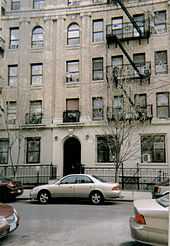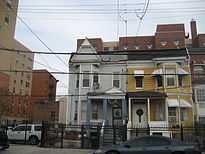Longwood, Bronx


Longwood is an urban, mixed use, primarily residential neighborhood geographically located in the southwest Bronx, New York City. The neighborhood is part of Bronx Community Board 2. Its boundaries, starting from the north and moving clockwise are: East 167th Street to the north, the Bronx River & the Bruckner Expressway to east, East 149th Street to the south, and Prospect Avenue to the west. Southern Blvd is the primary thoroughfare through Longwood. The local subway is the 6 <6> trains, operating along Southern Blvd. Zip codes include 10455 and 10459. The neighborhood is served by the NYPD's 41st [1] Precinct. NYCHA property in the area is patrolled by P.S.A. 7 at 737 Melrose Avenue in the Melrose section of the Bronx.
Demographics
Greater Longwood has a population density of 70,000 inhabitants per square mile (27,000 /km2) The neighborhood predominantly consist of Latin Americans (Longwood has one of the highest concentrations of Puerto Ricans in New York City) but includes a small yet diverse mix of races, ethnic groups, religious affiliations, sexual orientations, and national origins. Like most neighborhoods in New York City the vast majority of households are renter occupied. Almost half of the population lives below the federal poverty line and receives public assistance (AFDC, Home Relief, Supplemental Security Income, and Medicaid). This community is part of New York's 16th Congressional District, the poorest such district in the United States. However, there is significant income diversity on a block by block basis.[2]
Land use and terrain
Longwood is dominated by pre-war, 5- and 6-story apartment buildings. Starting in the 1990s, a construction boom has resulted in a number of modern apartment buildings and row houses. Much of the original housing stock was structurally damaged by arson and eventually razed by the city between mid and late 1900s.
Southern Blvd is a long standing, mixed use, primarily commercial district. The Southern Blvd B.I.D. (Formed in 2008) sits between the two points of closest proximity for the IRT Pelham and White Plain Road line.[3] Other primary thoroughfares contain limited but necessary amenities like supermarkets, pharmacies, barbershops, hair salons, fast food, bodegas, and cheap shops.
The total land area is roughly half a sq mi. The terrain is somewhat hilly.
Longwood Historic District
The landmarked Longwood Historic District is located south of Longwood Avenue along Beck, Kelly, Dawson Streets and Hewitt Place. The district largely consists of semi-detached row houses, most of which were designed by one architect, Warren C. Dickerson.[4][5]
Low income public housing projects
There are four NYCHA developments located in Longwood.[6]
- West Farms Square Rehab; four rehabilitated tenement buildings, 6-stories tall.
- East 165th Street-Bryant Avenue; five buildings, 3-stories tall.
- Longfellow Avenue Rehab; two, 5-story rehabilitated tenement buildings.
- Stebbins Avenue-Hewitt Place; two, 3-story buildings.
History



The Bronx initially began to become urban with the construction of a street-car network. Eventually, the expansion of the elevated and subterranean rapid transit lines from Manhattan rapidly accelerated development. Solid rows of 5 and 6 story, walk-up and larger elevator, apartment buildings were built to the sidewalk and dominated the landscape of Upper Manhattan, the West Bronx and in walking proximity of the elevated lines in the East Bronx. Commercial corridors quickly developed in close proximity to rapid transit stations and primary thoroughfares. Early in this construction boom, Longwood was one of the most dense and developed Bronx neighborhoods. For much the first half of the 20th Century, the borough of the Bronx was home to a predominantly middle class, White, European descent, Jewish population. Still, there was great diversity. Immigrants of varying socioeconomic status from a number of countries, but mostly European.
Beginning in the 1950s, the older, more developed parts of the Bronx experienced a socioeconomic shift due to a number of factors. The construction of the Cross Bronx Expressway displaced thousands and physically divided communities, Co-op City in the northeast Bronx offered modern amenities and spacious apartments, and suburban communities outside New York City became more appealing with their auto-centric lifestyle. As people with financial means began to leave, poverty stricken often replaced them. White flight and abandonment only accelerated over time. By the late 1960s, many buildings in the greater South Bronx had been burnt out in an epidemic of arson. Scammers realized they could manipulate the system and collect insurance money after more lucrative tenants had fled. The area was severely run down as the community became increasingly disfranchised. At this time, crime reached such a level that the 41st Precinct Station House at 1086 Simpson Street became known by the police as "Fort Apache", as was later immortalized in a 1981 movie named for it.[7]
The wave of arson eventually ended with the help of community groups such as Banana Kelly and SEBCO, who worked to bring recognition and protect the remaining apartment buildings in the greater South Bronx. What was left was a wasteland of abandoned buildings, vacant lots, filthy streets and a severe lack of even basic commercial amenities. During this period of time, the neighborhood was dealt another blow as violent crime hit historic highs during the crack epidemic. The police seemed to be fighting a losing battle as thousands of young men in New York City were regularly being killed on the streets over drug turf. The greater South Bronx was one of the hardest hit areas, with a largely poor population which lacked local jobs, many began to turn to the lucrative drug trade.
Some of the first federal funding in decades for new investment began in 1986 under the Ed Koch administration. In blighted neighborhoods across the city, various housing experiments were attempted. The NYCHA was one of the first agencies to create and renovate residential units in Longwood, the city soon followed up with independent, locally driven developments. This construction resulted in escalating reinvestment in these communities Continuing into the mid-1990s, local and federal governments invested over $550 million in new subsidized residential housing and the expansion of businesses and commerce. With the building of the South Bronx headquarters of P.A.L.; the relocation of the 41st Precinct of the NYPD from Simpson Street to Longwood Avenue; the Banana Kelly High School; and several small and large businesses (such as Rite Aid and McDonald's). This investment has only increased exponentially since that time. A vast number of new housing and commercial units have been constructed on formally vacant lots, with more planned. A community once dominated by blight and disinvestment, is now towered over by modern apartment buildings, renovated pre-wars, and rows of attached row houses. Social problems persist due to a significant percentage of the population living in poverty. Crime for instance has declined versus historic highs in the 1990s, but remain well above average in New York City. However, the neighborhood has come a long way.

Schools
- PS 333: The Museum School (East 163rd Street and Rev. James A. Polite Avenue)
- PS 335: The Academy of the Arts (East 163rd Street and Rev. James A. Polite Avenue)
- PS 62: Inocencio Casanova (Leggett Avenue and Fox Street)
- PS 130: Abram Stevens Hewitt (East 156th Street and Prospect Avenue)
- PS 150: Charles James Fox (East 167th Street and Fox Street)
- MS 302: Luisa Dessus Cruz (Kelly Street and Avenue St. John)
- Bronx Regional High School (East 165th Street and Rev. James A. Polite Avenue)
- South Bronx Classical Charter School (Westchester Avenue and Fox Street)
Transportation
- Bx4/Bx4A: to Westchester Square – East Tremont Avenue (6 <6>) (via Westchester Avenue)
- Bx5: to Pelham Bay Park (via Story Avenue)
- Bx6: to Hunts Point or Riverside Drive-158th Street, Manhattan (via 161st and 163rd Streets)
- Bx11: to George Washington Bridge Bus Terminal (via 170th St and Claremont Pkwy)
- Bx17: to Fordham Plaza or Port Morris (via Prospect and Crotona Avenues)
- Bx19: to New York Botanical Gardens or Riverbank State Park (via 149th Street and Southern Boulevard)
- Bx27: to Clason Point (via Rosedale Avenue)
- Bx35: to George Washington Bridge Bus Terminal (via 167th Street)
- Bx46: to Prospect Avenue (IRT White Plains Road Line) (2 5) or Hunts Point (via Longwood and Tiffany Streets)
- Whitlock Avenue (IRT Pelham Line) (6)
- Simpson Street (IRT White Plains Road Line) (2 5)
- Intervale Avenue (IRT White Plains Road Line) (2 5)
- Hunts Point Avenue (IRT Pelham Line) (6 <6>)
- Prospect Avenue (IRT White Plains Road Line) (2 5)
- Longwood Avenue (IRT Pelham Line) (6)
- East 149th Street (IRT Pelham Line) (6)
References
- ↑ 41st Precinct, NYPD.
- ↑ Bronx Community District 2
- ↑ Southern Blvd BID
- ↑ Longwood Historic District
- ↑ Larry E. Gobrecht (June 1981). "National Register of Historic Places Registration: Longwood Historic District". New York State Office of Parks, Recreation and Historic Preservation. Retrieved 2011-01-12.
- ↑ NYCHA
- ↑ Fisher, Ian (1993-06-23). "Pulling Out of Fort Apache, the Bronx; New 41st Precinct Station House Leaves Behind Symbol of Community's Past Troubles". The New York Times. Retrieved 2007-12-26. "He stretched his memory back 25 years to his days as a rookie patrolman in the 41st Precinct, whose station house was known from here to Hollywood as Fort Apache, a solitary outpost in a neighborhood of death and decay and gangs with grandiosely macabre names."
External links
Coordinates: 40°49′02″N 73°53′57″W / 40.8173229°N 73.8993029°W
